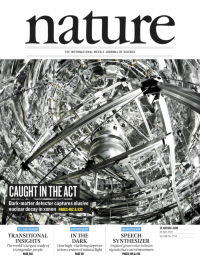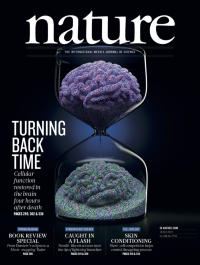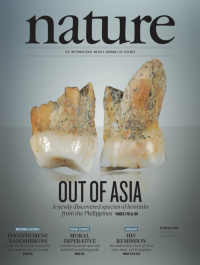Volume 568
-
No. 7753 25 April 2019
Caught in the actThe cover shows the inside of the water shield surrounding the XENON1T dark-matter detector at the INFN Gran Sasso National Laboratory near L’Aquila in Italy. In this week’s issue, the XENON Collaboration reveals that the set-up has recorded a type of nuclear decay that is particularly hard to detect. The team has directly observed two-neutrino double electron capture in xenon-124, the half-life of which is roughly a trillion times the age of the Universe. The XENON1T detector contains 3.2 tonnes of ultra-pure xenon, and allowed the researchers to detect the X-rays emitted when xenon-124 decays into tellurium-124. They measured the half-life of this decay to be 1.8 × 10^22 years, which is in line with predictions. The team says that this detection is a useful step on the road to detecting neutrinoless double electron capture processes, which could provide a deeper understanding of the neutrino.
Spotlight
-
No. 7752 18 April 2019
Turning back timeThe mammalian brain is extremely sensitive to fluctuations in oxygen supply and even short periods of time without blood circulation and oxygen can lead to cell death and irreparable damage. In this week’s issue, Nenad Sestan and his colleagues reveal a technological platform consisting of a perfusion device, a cytoprotective and anti-neuronal activity solution, as well as a surgical procedure that can restore microcirculation and cellular functions in an isolated porcine brain multiple hours after death. The system, named BrainEx, is designed to mimic pulsating blood flow at normal body temperature as it circulates the protective solution through the isolated brain. Four hours after the porcine brains were removed from the body, the researchers introduced them to the BrainEx system. During a six-hour perfusion period, the team saw a reduction in cell death and the restoration of some cellular functions including synaptic activity, but in the absence of global electrical activity. The team says that it may be possible to use its perfusion system on other organs besides the brain to preserve tissue function after the death of the host.
-
No. 7751 11 April 2019
Out of AsiaThe cover shows two molars from a newly discovered hominin species named Homo luzonensis . Described in this issue by Florent Détroit, Armand Mijares, Philip Piper and their colleagues, H. luzonensis lived on the island of Luzon in the Philippines prior to 50,000 years ago. The partial remains of at least three individuals, consisting of teeth, several foot and hand bones, and a partial femur, were uncovered by the researchers in Callao Cave. These bones add to a single foot bone found in the cave in 2007 and dated to 67,000 years ago, allowing the team to make a formal diagnosis of the new species. Alongside Homo floresiensis, the dwarf hominin discovered on Flores in Indonesia, the discovery of H. luzonensis underscores the significance of island populations in southeast Asia in the evolution of the genus Homo. Although the two species were different, their situations were possibly similar: relics of populations of earlier hominins marooned on remote islands and following their own evolutionary trajectories.
Nature Outlook
-
No. 7750 4 April 2019
Rough guideThe cover shows the first image of the near-Earth asteroid (101955) Bennu taken by NASA’s OSIRIS-REx spacecraft. The mission ultimately aims to collect samples from the asteroid’s surface, but the initial view of Bennu suggests this may be a trickier task than anticipated. In this issue, Dante Lauretta and his co-authors present early observations of Bennu’s properties. They find that the bulk composition of the asteroid seems to be hydrated and volatile-rich, as was expected. But the imaging reveals that Bennu’s surface is far rockier than was predicted, giving the sample-retrieval mission only a small number of apparently hazard-free regions, some 5–20 metres in extent, that could be safely targeted.




